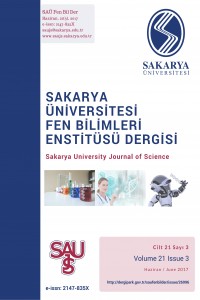Kesikli Regresyon Modellerinin Kullanımıyla Midye Parazit Sayılarındaki Sıfır Yoğunluğunun Açıklanması
Abstract
Ekolojik çalışmaların
çoğunda, ya örneklemlerdeki belirleme hataları ya da türlerin varlıkları için
elverişsiz yaşam koşulları sebebiyle, türlerin yoklukları kaçınılmazdır ve
bunun sonucu olarak çok fazla miktarda sıfır sayısı ya da bolluğu ortaya çıkar.
Bu tipteki veriler için genellikle log(bolluk+1) regresyon modellemesi yapılır
ve oluşturulan modelinin kestirim için yetersiz olduğu bilinen bir gerçektir.
Sıfır sayılı bollukları içeren, aralarında sıfır ağırlıklı regresyon (ZIP ve
ZINB), engelli-poisson (HP) ve engelli negatif binom (HNB) bulunan yeni kesikli
modeller klasik regresyon modellerine göre daha çok tercih edilmektedir.
Türkiye için ekonomik açıdan en önemli deniz ürünlerinden biri olması
nedeniyle, bu çalışmada Akdeniz midyelerinin (Mytilus galloprovincialis L.)
varoluşlarının tehditi Nematopsis legeri paraziti için önemli biyotik ve
abiyotik faktörlerin belirlenmesinde bu dört modelin performanslarının
kıyaslanması amaçlanmıştır. Türkiye’nin Sinop şehrinin üç kıyı bölgesinden
toplanan parazitlerin sayılarının ortalamada %50’den fazlasının sıfır değerli
olduğu görülmüş ve oluşturulan modellerin kıyaslaması bilgi kriterleri ile
yapılmıştır. Sonuçlar bu parazitlerin oluşma olasılıklarını en iyi ZINB ve HNB
modelleriyle ifade edildiğini göstermiştir ve modellerde etkili faktörlerin
bölgelerin çevresel farklılıklarıyla ilişkili olduğu bulunmuştur.
Keywords
Parazit sayısı Poisson regresyon Negatif binom regresyon Sıfır ağırlıklı regresyon modeli Engelli model Akdeniz midyeleri
References
- H. Greene, "Organisms in nature as a central focus for biology," Trends in Ecology and Evolution, vol. 20, pp. 23-27, 2005.
- R. O’Hara and J. Kotze, "Do not log-transform count data," Methods in Ecology and Evolution, vol. 1, pp. 118-122, 2010.
- A. Agresti, Categorical Data Analysis, New York: John Wiley& Sons Inc., 2002.
- J. Hilbe, Negative Binomial Regression 2nd Edition, UK: Cambridge University Press, 2001.
- M. Chipeta, B. Ngwir, C. Simoonga and L. Kazembe, "Zero adjusted models with applications to analysing helminths count data," November 2014. [Online]. Available: http://bmcresnotes.biomedcentral.com/articles/10.1186/1756-0500-7-856.
- W. Greene, "Accounting for Excess Zeros and Sample Selection in Poisson and Negative Binomial Regression Models," NYU Working Paper No. EC-94-10, 1994.
- D. Lambert, "Zero-inflated Poisson regression with an application to defects in manufacturing," Technometrics,, vol. 34, pp. 1-14, 1992.
- J. Prasad, Zero-Inflated Censored Regression Models: An Application with Episode of Care Data, USA: M.S. thesis, Dept. Statistics, Brigham Young University, 2009.
- J. Cragg, "Some Statistical Models for Limited Dependent Variables with Application to the Demand for Durable Goods," Econometrica, vol. 39, pp. 829-844, 1971.
- H. Williams and A. Jones, Parasitic worms of fish, London: Taylor & Francis, 1994.
Abstract
In many ecological applications, the absences of species are inevitable due to either detection faults in samples or
uninhabitable conditions for their existence, resulting in high number of zero counts or abundance. Usual practice for
modelling such data is regression modelling of log(abundance+1) and it is well know that resulting model is
inadequate for prediction purposes. New discrete models accounting for zero abundances, namely zero-inflated
regression (ZIP and ZINB), Hurdle-Poisson (HP) and Hurdle-Negative Binomial (HNB) amongst others are widely
preferred to the classical regression models. Due to the fact that mussels are one of the economically most important
aquatic products of Turkey, the purpose of this study is therefore to examine the performances of these four models
in determination of the significant biotic and abiotic factors on the occurrences of Nematopsis legeri parasite
harming the existence of Mediterranean mussels (Mytilus galloprovincialis L.). The data collected from the three
coastal regions of Sinop city in Turkey showed more than 50% of parasite counts on the average are zero-valued and
model comparisons were based on information criterion. The results showed that the probability of the occurrence of
this parasite is here best formulated by ZINB or HNB models and influential factors of models were found to be
correspondent with ecological differences of the regions.
Keywords
Parasite counts Poisson regression Negative binomial regression Zero-inflated regression model Hurdle model Mediterranean mussels
References
- H. Greene, "Organisms in nature as a central focus for biology," Trends in Ecology and Evolution, vol. 20, pp. 23-27, 2005.
- R. O’Hara and J. Kotze, "Do not log-transform count data," Methods in Ecology and Evolution, vol. 1, pp. 118-122, 2010.
- A. Agresti, Categorical Data Analysis, New York: John Wiley& Sons Inc., 2002.
- J. Hilbe, Negative Binomial Regression 2nd Edition, UK: Cambridge University Press, 2001.
- M. Chipeta, B. Ngwir, C. Simoonga and L. Kazembe, "Zero adjusted models with applications to analysing helminths count data," November 2014. [Online]. Available: http://bmcresnotes.biomedcentral.com/articles/10.1186/1756-0500-7-856.
- W. Greene, "Accounting for Excess Zeros and Sample Selection in Poisson and Negative Binomial Regression Models," NYU Working Paper No. EC-94-10, 1994.
- D. Lambert, "Zero-inflated Poisson regression with an application to defects in manufacturing," Technometrics,, vol. 34, pp. 1-14, 1992.
- J. Prasad, Zero-Inflated Censored Regression Models: An Application with Episode of Care Data, USA: M.S. thesis, Dept. Statistics, Brigham Young University, 2009.
- J. Cragg, "Some Statistical Models for Limited Dependent Variables with Application to the Demand for Durable Goods," Econometrica, vol. 39, pp. 829-844, 1971.
- H. Williams and A. Jones, Parasitic worms of fish, London: Taylor & Francis, 1994.
Details
| Subjects | Mathematical Sciences |
|---|---|
| Journal Section | Research Articles |
| Authors | |
| Publication Date | June 1, 2017 |
| Submission Date | November 2, 2016 |
| Acceptance Date | January 16, 2017 |
| Published in Issue | Year 2017 Volume: 21 Issue: 3 |
Cite
INDEXING & ABSTRACTING & ARCHIVING
Bu eser Creative Commons Atıf-Ticari Olmayan 4.0 Uluslararası Lisans kapsamında lisanslanmıştır .

